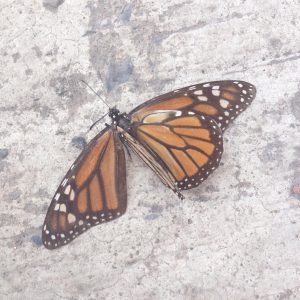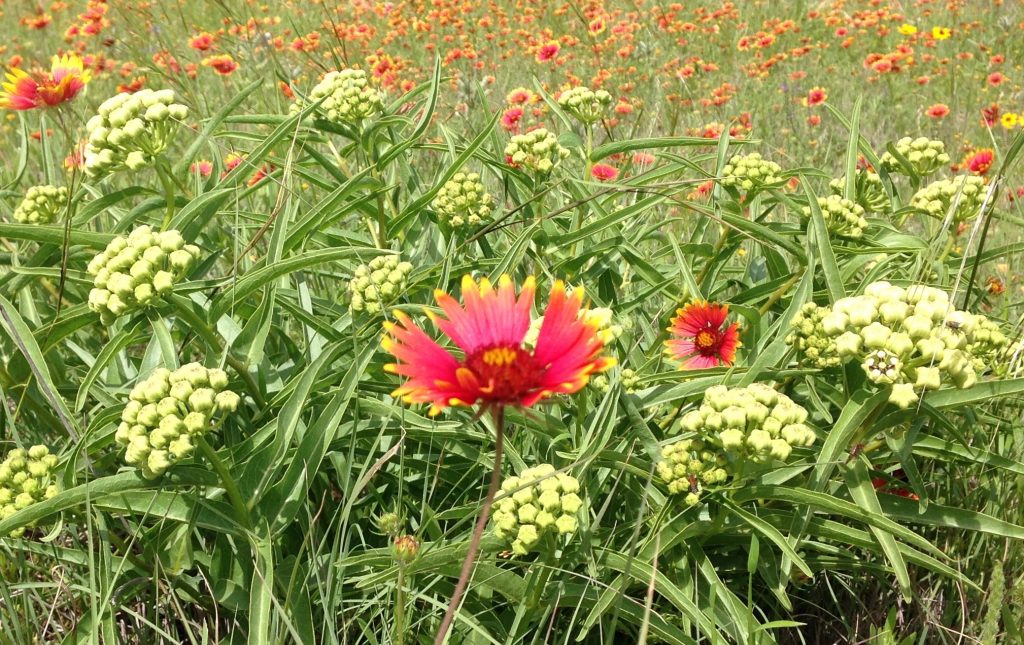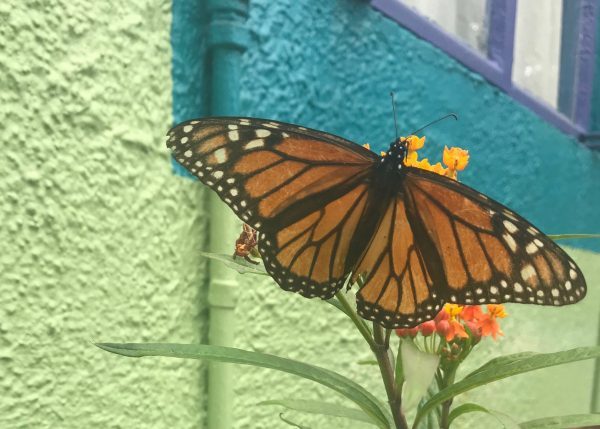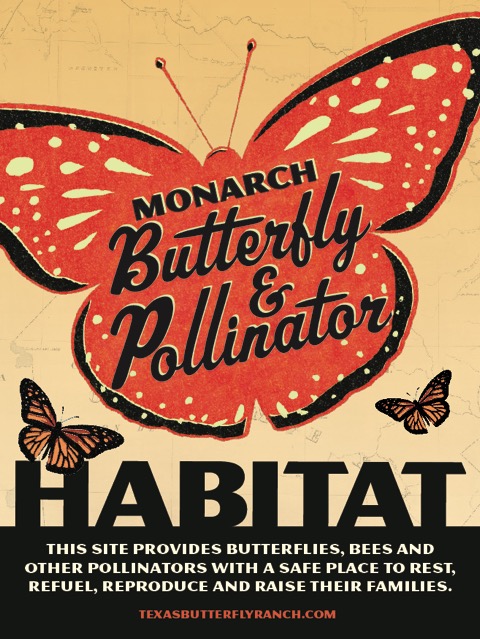Monarch butterflies have begun their multi-generation migration north from Mexico, following a season that counted their largest overwintering population in a decade. Favorable conditions in South Texas suggest we may be in for another great year.
Early reports had the butterflies moving out of the high mountain preserves in Michoacán and the state of Mexico as early as mid February. Journey North, a citizen science program that tracks various wildlife migrations, cited a “gradual departure” in their weekly bulletin February 24. A week later, the organization announced a stop-and-start pattern of the migrating butterflies, attributed to schizophrenic weather.
Warm weather encourages the butterflies to take flight, while flash cold spells like those experienced in South Texas in recent weeks can stop them in their tracks. Members of the Mexican citizen science platform Correo Real have been reporting serial sightings throughout northern Mexico for weeks.

Sandra Acosta reported this dead monarch on March 6 in Ciudad Victoria, Tamaulipas. Photo via Correo Real, WhatsApp
“The spring migration has begun!” Correo Real’s Facebook page announced on February 21.
Correspondents that communicate through the organization’s What’sapp group reported sightings of monarchs mating, flying and as road kill all along the northward migratory route, from locations in Guanajuato, Tamaulipas and Coahuila.
In San Antonio, Monarch Larvae Monitoring Project volunteer Mary Kennedy saw her FOS, or “first-of-season” monarch on February 26.
“They are here! First large, faded monarch of the spring season flew SW to NE across my garden today!” Kennedy reported in a Facebook post, adding, “Hope they find milkweed in South Texas Brush Country!”
Early arrivals can cause concerns, since the butterflies need milkweed on which to lay their eggs and launch 2019’s new generation. Depending on conditions, milkweed may or may not be out of the ground to provide host plant for successful egg laying. If there’s no milkweed, the butterflies keep flying in search of it and can die before egg laying takes place.
Others in San Antonio saw their first-of-season monarchs this week. “Monarchs are here! One yesterday, two today,” said Veronica Prida in Alamo Heights. The photo at the top of this post of a tattered female on Tropical milkweed was taken by her husband, Omar Rodriguez, on March 12. Drake White, of the Nectar Bar, spotted two females on mountain laurel on March 8; another graced my downtown pollinator garden on March 10.
Warm South Texas weather in late February likely coaxed the migrating butterflies north, but then a cold snap put the skids on northward movement. Cold weather usually halts the butterflies’ travels, causing them to stay in place and wait out the weather.

Migrant monarch on mountain laurel. Photo by Drake White, Nectar Bar
Monarch scientist Chip Taylor, founder of the citizen science tagging program Monarch Watch based at the University of Kansas at Lawrence, laid out a generally positive forecast for the 2019 season.
“The first bit of good news is the sighting of 27 monarchs in Texas in the first 10 days of March,” Taylor wrote on March 12 in an update on the DPLEX, an online community of email subscribers that includes scientists, citizen scientists, monarch butterfly hobbyists and others. He said that was a record since Journey North started keeping records in 2000. Numerous sightings have been reported, some as far north as Austin, he said, and it’s likely that “most of the monarchs are still en route and we know that substantial numbers still remain at some of the colonies.”
Taylor pointed out that good weather and favorable conditions exist for feeding, mating, egg laying, larval growth rate and movement to the NE. He added that it appears that most of the returning monarchs will lay their eggs in Texas and the southern half of Oklahoma. “Restricting egg production to Texas and Oklahoma is a good thing since it will minimize the average age to first reproduction of the progeny of the returning monarchs,” he said.

Monarchs will be looking for milkweed like these about-to-bloom white Antelope horns, the butterflies’ host plant on which they lay eggs. Indian blanket will provide nectar. Photo by Monika Maeckle
While no specific sightings of massive native milkweed stands have been reported, other wildflowers await the migrating insects and appear to be on an early schedule as well. Several sources reported a massive, early bloom of bluebonnets in Big Bend.
Photographer Lee McMullen told Texas-centric travel website TexasHillCountry.com that he hadn’t seen a bloom like this in thirty years. In late February, Colette Pearce of Austin relayed that the bluebonnets at Big Bend National Park were “amazing” this year.
“I believe they were at least two weeks earlier than when I witnessed the incredible bloom of 2015,” she wrote on Facebook in response to a post by the Texas Wildflower Report.
“I think we’re probably going to have a pretty solid year,” Andrea DeLong-Amaya, Horticulture Director at the Ladybird Johnson Wildflower Center, told the Texas Standard this week. “We’ve had good rain and that’s always the key in terms of how good the show actually is,” she said, adding that wildflowers are well adapted to cold temperatures.
Taylor said much the same speculating about this year’s monarch butterfly crop: “The bottom line — I’m cautiously optimistic that the population will get off to a good start this breeding season.”
Want to help monarch butterflies, bees and other pollinators? Plant a pollinator garden and register it to be mapped on our 300for300 pollinator gardening initiative.
TOP: Feature photo of worn female on milkweed by Omar Rodriguez.
Related posts:
- Migrating monarch butterfly popoulations vaults 144%, highest in 12 years
- Monarch butterfly population up in Mexico, down in California
- Monarch butterfly population drops 27%, freak sleet storm to blame
- Weird, late migration finally reaches Mexico
- Banner year for monarch butterfly migration? Texas Hill Country ready
- Five monarch butterflies tagged at Monarch Festival in San Antonio make it to Mexico
- How to Tag a Monarch Butterfly in Six Easy Steps
- What does climate change mean for Monarch butterflies?
- New study: late season nectar plants more important than milkweed to Monarch migration
- Monarch butterflies head north as Mexican scientists try to move their forest
Like what you’re reading? Follow butterfly and native plant news at the Texas Butterfly Ranch. Sign up for email delivery at the bottom of this page, like us on Facebook, or follow us on Twitter, @monikam.



Oh, I do hope this “bomb cyclone” will not kill ones that are early arrivals!
Recently I have found several good patches of green milkweed in the Arlington/Grand Prairie area. Mostly along Highway 360 and Barden Road. Hope the mowers miss them for the fall flight.
I have no flowers this year. I have put out a butterfly feeder (fermented fruit in a hanging feeder I made myself.) It has attracted some small gray butterflies that I can’t identify in my butterfly book: little gray ones with black spots on the periphery of the wing, and one black and blue one about the size of a quarter. At any rate, do I have any chance of attracting Monarchs?
MR in Northeast Texas.
I hadn’t thought of this before lthough it sounds like a great idea. Please monitor your feeder if possible. Of course if you want to go all out you can put up a butterfly feeder “webcam” then spread the web address around so we can all watch. We can also do a rain dance so the native milkweed reemerges for that “migration generation” egg laying and help wildflowers emerge to feed our traveling friends. Of course attending Monika’s festival in San Antonio is a must. Maybe she will put up some feeders during the festival to attract monarchs to the festivities. Monika also has a great pollinator garden initiative going. You can supplemental water your plants if there’s drought conditions. Monika has Been referred to as the monarch “evangelist. She’s doing a great job living up to her handle by inspiring others to join the cause for monarchs and. Pollinators in general. http://Www.TexasButterflyRanch.com